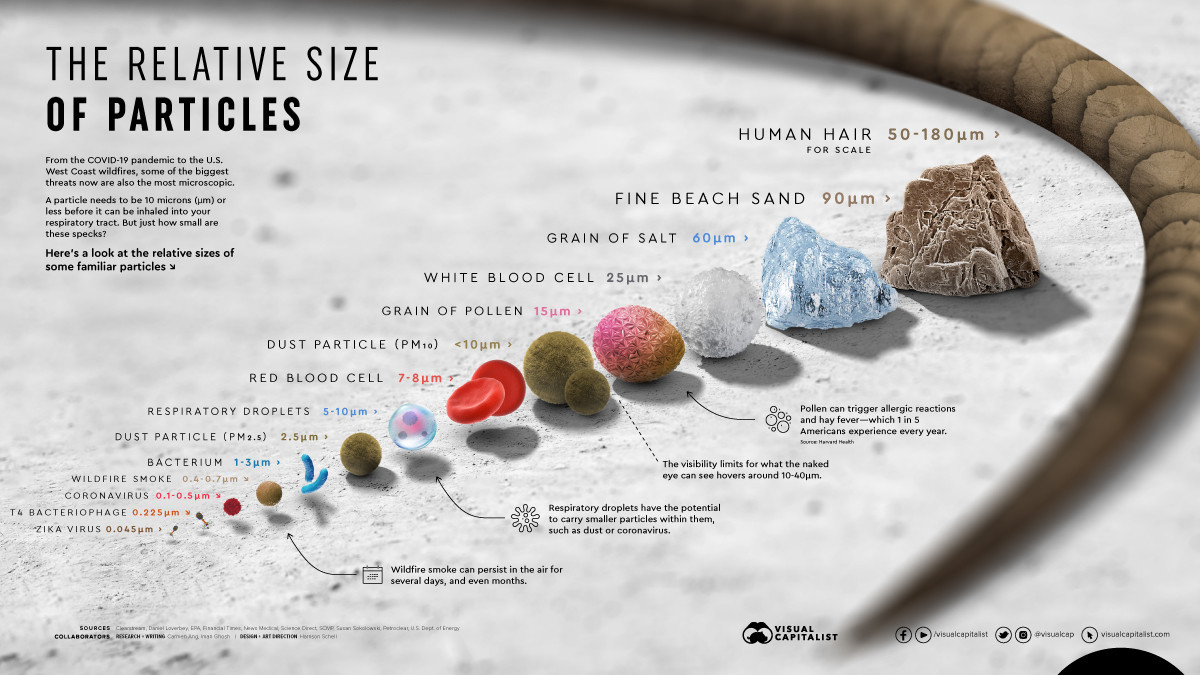This is how coronavirus compares to the world's smallest particles

Air pollution is one of the leading causes of death worldwide. Image: REUTERS/Stringer

Get involved with our crowdsourced digital platform to deliver impact at scale
Stay up to date:
Air Pollution
- From COVID-19 to air pollution, lately some of the world's biggest threats have been microscopic in size.
- This chart shows how different diseases, germs and particles all compare in size.
- Zika, E-Coli and COVID-19 are some of the smallest particles there are.
View the high resolution of this infographic by clicking here.
Lately, the world’s biggest threats have been microscopic in size.
From the global COVID-19 pandemic to wildfires ripping through the U.S. West Coast, it seems as though our lungs can’t catch a break, or more aptly, a breath.
But just how small are the particles we’re currently battling? And how does their size compare to other tiny molecules?
Specks too small to see
While the coronavirus that causes COVID-19 is relatively small in size, it isn’t the smallest virus particle out there.
Both the Zika virus and the T4 Bacteriophage—responsible for E. coli—are just a fraction of the size, although they have not nearly claimed as many lives as COVID-19 to date.
Coronavirus particles are smaller than both red or white blood cells, however, a single blood cell is still virtually invisible to the naked eye. For scale, we’ve also added in a single human hair as a benchmark on the upper end of the size range.
On the other end of the spectrum, pollen, salt, and sand are significantly larger than viruses or bacteria. Because of their higher relative sizes, our body is usually able to block them out—a particle needs to be smaller than 10 microns before it can be inhaled into your respiratory tract.
Because of this, pollen or sand typically get trapped in the nose and throat before they enter our lungs. The smaller particles particles, however, are able to slip through more easily.
Smoky skies: air pollution and wildfires
While the virus causing COVID-19 is certainly the most topical particle right now, it’s not the only speck that poses a health risk. Air pollution is one of the leading causes of death worldwide—it’s actually deadlier than smoking, malaria, or AIDS.
One major source of air pollution is particulate matter, which can contain dust, dirt, soot, and smoke particles. Averaging around 2.5 microns, these particles can often enter human lungs.
At just a fraction of the size between 0.4-0.7 microns, wildfire smoke poses even more of a health hazard. Research has also linked wildfire exposures to not just respiratory issues, but also cardiovascular and neurological issues.
Here’s an animated map by Flowing Data, showing how things heated up in peak wildfire season between August-September 2020:
What’s the main takeaway from all this?
There are many different kinds of specks that are smaller than the eye can see, and it’s worth knowing how they can impact human health.
Don't miss any update on this topic
Create a free account and access your personalized content collection with our latest publications and analyses.
License and Republishing
World Economic Forum articles may be republished in accordance with the Creative Commons Attribution-NonCommercial-NoDerivatives 4.0 International Public License, and in accordance with our Terms of Use.
The views expressed in this article are those of the author alone and not the World Economic Forum.
The Agenda Weekly
A weekly update of the most important issues driving the global agenda
You can unsubscribe at any time using the link in our emails. For more details, review our privacy policy.
More on Nature and BiodiversitySee all
Charlotte Kaiser
April 23, 2024
Jennifer Holmgren
April 23, 2024
Agustin Rosello, Anali Bustos, Fernando Morales de Rueda, Jennifer Hong and Paula Sarigumba
April 23, 2024
Carlos Correa
April 22, 2024
Nick Pickens and Julian Kettle
April 22, 2024
Simon Torkington
April 22, 2024








